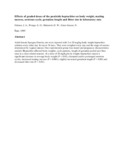| dc.contributor.author | Oduma, J A | |
| dc.contributor.author | Wango, E O | |
| dc.contributor.author | Makawiti, D W | |
| dc.contributor.author | Einer-Jensen, N | |
| dc.date.accessioned | 2013-03-15T13:12:12Z | |
| dc.date.issued | 1995 | |
| dc.identifier.citation | Compo Biochem. Physiol. Vol. IIOC, No.2, pp. 221-227, 1995 | en |
| dc.identifier.uri | http://erepository.uonbi.ac.ke:8080/xmlui/handle/123456789/14175 | |
| dc.identifier.uri | http://www.ncbi.nlm.nih.gov/pubmed/7599970 | |
| dc.description.abstract | Adult female Sprague-Dawley rats were injected with 5 or 20 mg/kg body weight heptachlor solution every other day for up to 18 days. They were weighed every day and the stage of oestrus determined by vaginal smears. One experimental group was mated and pregnancy characteristics studied. Heptachlor affected body weights, cycle patterns, length of gestation period and litter sizes in a dose-related manner. At a dose of 20 mg/kg body weight, heptachlor caused a significant decrease in average body weight (P < 0.01), disrupted and/or prolonged oestrous cycles, decreased mating success (P < 0.001), slightly increased gestation length (P < 0.05) and decreased litter size (P < 0.01). | en |
| dc.language.iso | en | en |
| dc.subject | Pesticide; | en |
| dc.subject | Chlorinated hydrocarbons; | en |
| dc.subject | Heptachlor; | en |
| dc.subject | Oestrous; | en |
| dc.subject | Gestation length; | en |
| dc.subject | Litter size | en |
| dc.subject | Rats | en |
| dc.title | Effects of graded doses of the pesticide heptachlor on body weight, mating success, oestrous cycle, gestation length and litter size in laboratory rats | en |
| dc.type | Article | en |
| local.publisher | Reproductive Biology Unit, University of Nairobi, | en |
| local.publisher | Department of Biochemistry, University of Nairobi, | en |
| local.publisher | Department of Veterinary Anatomy, University of Nairobi, | en |

